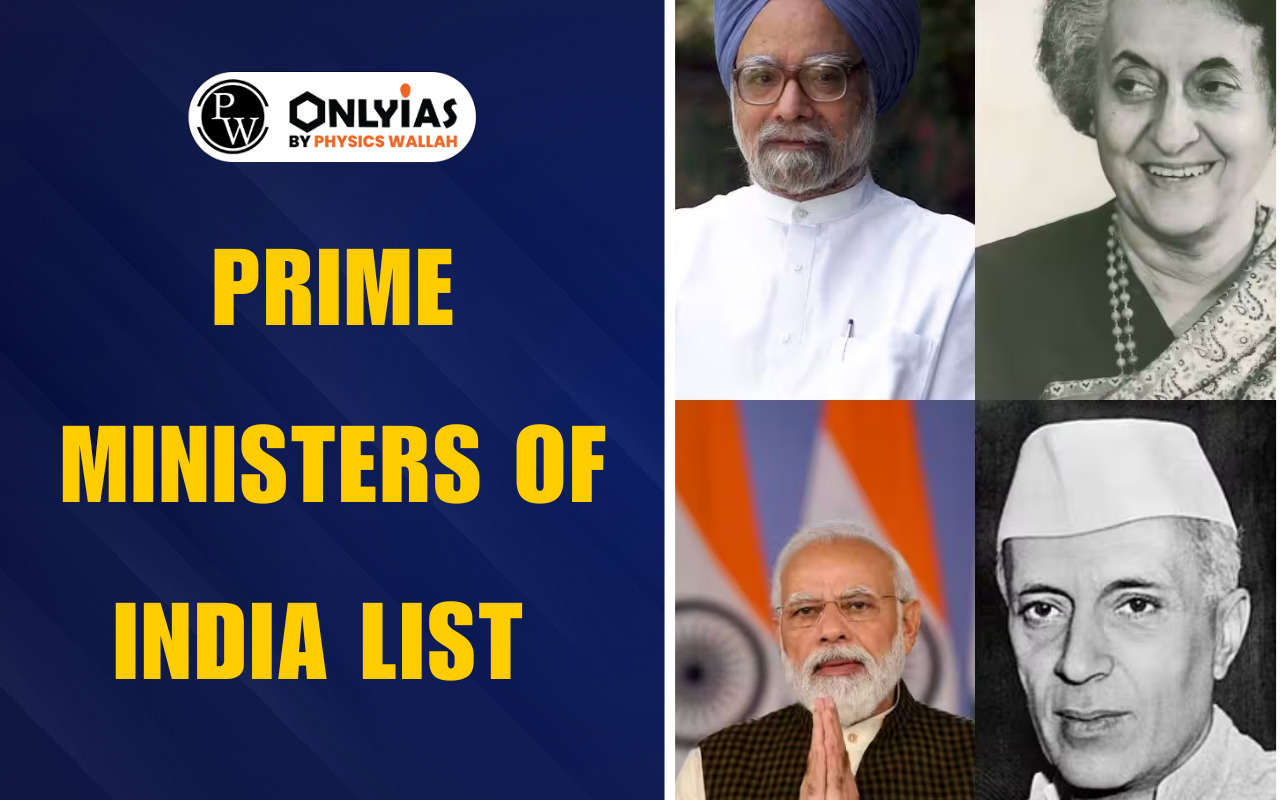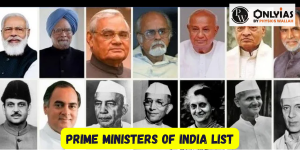Since 1947, India has had 14 prime ministers. Jawaharlal Nehru was India's first prime minister, serving as prime minister of the Dominion of India from 15 August 1947 until 26 January 1950, and thereafter of the Republic of India until his death in May 1964, and current Prime Minister of India is Narendra Modi, who has been in office since May 26, 2014.

Prime Ministers of India: The number of Prime Ministers of India from 1947 to 2025 have been 14. The first Prime Minister of India, Pandit Jawaharlal Nehru, assumed office in 1947. The current Prime Minister of India is Shri Narendra Modi.
In the general elections of 2024, Shri Narendra Modi has won, making him one of the two prime ministers of India who has been elected for the third consecutive term.
Let us have a look at the complete Prime Ministers of India List from 1947 to 2025. The comprehensive Prime Ministers of India List from 1947 to 2025, with their tenures in the office is also given here.
Prime Ministers of India holds the position of the head of government and is appointed by the President of India after the general elections. When the nominated candidate of a political party emerges as the winner in the general elections, the candidate who secures the majority of votes is designated as the Prime Minister of India.

Prime Ministers of India List
A comprehensive summary of India’s Prime Ministers, detailing their terms, durations, and notable achievements or distinctions is given in below table:
| N. | PM Name | Born-Dead | Term of Office | Term of Office in Years and Days | Remark |
| 1. | Jawaharlal Nehru | (1889–1964) | 15 August 1947 to 27 May 1964 | 16 years, 286 days | First Prime Minister of India and the longest-serving PM. |
| 2. | Gulzarilal Nanda (Acting) | (1898-1998) | 27 May 1964 to 9 June 1964 | 13 days | First acting Prime Minister of India. |
| 3. | Lal Bahadur Shastri | (1904–1966) | 9 June 1964 to 11 January 1966 | 1 year, 216 days | Third Prime Minister, known for the Green and White Revolutions and the slogan ‘Jai Jawan Jai Kisan’. |
| 4. | Gulzarilal Nanda (Acting) | (1898-1998) | 11 January 1966 to 24 January 1966 | 13 days | Served two brief terms as acting Prime Minister; awarded the Bharat Ratna in 1997. |
| 5. | Indira Gandhi | (1917–1984) | 24 January 1966 to 24 March 1977 | 11 years, 59 days | First female Prime Minister of India. |
| 6. | Morarji Desai | (1896–1995) | 24 March 1977 to 28 July 1979 | 2 years, 126 days | Passed away at age 99, becoming the world’s oldest former head of government. |
| 7. | Charan Singh | (1902–1987) | 28 July 1979 to 14 January 1980 | 170 days | Only Prime Minister who did not face Parliament. |
| 8. | Indira Gandhi | (1917–1984) | 14 January 1980 to 31 October 1984 | 4 years, 291 days | First lady to serve two terms as Prime Minister. |
| 9. | Rajiv Gandhi | (1944–1991) | 31 October 1984 to 2 December 1989 | 5 years, 32 days | Youngest Prime Minister at 40 years old. |
| 10. | V. P. Singh | (1931–2008) | 2 December 1989 to 10 November 1990 | 343 days | First Prime Minister to resign after a vote of no confidence. |
| 11. | Chandra Shekhar | (1927–2007) | 10 November 1990 to 21 June 1991 | 223 days | Member of the Samajwadi Janata Party. |
| 12. | P. V. Narasimha Rao | (1921–2004) | 21 June 1991 to 16 May 1996 | 4 years, 330 days | First Prime Minister from South India. |
| 13. | Atal Bihari Vajpayee | (1924-2018) | 16 May 1996 to 1 June 1996 | 16 days | Served the shortest tenure as Prime Minister. |
| 14. | H. D. Deve Gowda | (born 1933) | 1 June 1996 to 21 April 1997 | 324 days | Focused on farmers and initiated the Delhi Metro project; known as the ‘son of the soil’. |
| 15. | Inder Kumar Gujral | (1919–2012) | 21 April 1997 to 19 March 1998 | 332 days | Served less than a year as Prime Minister after various ministerial roles. |
| 16. | Atal Bihari Vajpayee | (1924-2018) | 19 March 1998 to 22 May 2004 | 6 years, 64 days | First non-Congress Prime Minister to complete a full term. |
| 17. | Manmohan Singh | (born 1932) | 22 May 2004 to 26 May 2014 | 10 years, 4 days | First Sikh Prime Minister; passed the Right to Information Act and NREGA. |
| 18. | Narendra Modi | (born 1950) | 26 May 2014 to 30 May 2019 | 5 years, 4 days | Fourth Prime Minister to serve three consecutive terms. |
| 19. | Narendra Modi | (born 1950) | 30 May 2019 to 7 June 2024 | 5 years, 9 days | First non-Congress Prime Minister with three consecutive terms. |
| 20. | Narendra Modi | (born 1950) | 9 June 2024 – Incumbent | Incumbent | Served as Chief Minister of Gujarat for 14 years, praised for economic growth and infrastructure. |
The appointment is made by the President of India and is granted to the leader of the majority party in the Lok Sabha, the lower house of the Parliament of India. As per Article 75 of the Constitution of India, the President appoints the Prime Minister, who is expected to command the confidence of the majority of the members of the Lok Sabha.
Narendra Modi currently serves as the 14th Prime Minister of India. He has now become the second Prime Minister in Indian history to be elected in three consecutive terms, marking a historic achievement as the first non-Congress Prime Minister to complete two consecutive terms.
The Current Prime Minister of India, Shri Narendra Modi has been elected for this third consecutive term in the General Elections 2024. He has now become only the second Prime Minister after Pt Jawaharlal Nehru, to be elected for a third consecutive term.
Prime Ministers in India serve for a maximum of 5 years. Shri Narendra Modi was first elected as the Prime Minister of India in 2014. He has since won the 2019 elections as well as the most recent 2024 General Elections.
Pandit Jawaharlal Nehru, representing the Indian National Congress, became the first Prime Minister of India on 15th August 1947, following India’s independence. He assumed office on the same day India gained freedom and served as Prime Minister until 15th April 1952.
His appointment was made by Lord Mountbatten, the last Viceroy of India, marking the beginning of India’s democratic journey under its first Prime Minister.

First Prime Minister of India: Jawaharlal Nehru
In India, the political system operates under a parliamentary model, where the Prime Minister assumes the dual responsibilities of being the head of the executive branch and the presiding authority. The Lok Sabha, as the primary legislative body of the Republic of India, functions as the lower house of the Indian Parliament.
Typically, the Prime Minister is the leader of the political party or coalition that commands a majority in the Lok Sabha. As a result, the Lok Sabha serves as a constant mechanism for holding the Prime Minister accountable for their actions and decisions.
The President of India appoints the Prime Minister, but the Prime Minister must maintain the support of the majority of Lok Sabha members to continue in office. Lok Sabha members are directly elected every five years.
The Prime Minister can be a member of either the Rajya Sabha or the Lok Sabha, which are the two houses of Parliament. The Prime Minister wields complete authority over the appointment, removal, and allocation of positions within the Union Council of Ministers and the government.
Let us have a look at a brief introduction of all the Prime Ministers of India from 1947 to 2025:
Below is a table listing all the Prime Ministers of India from 1947 to 2025, along with a brief explanation of each Prime Minister’s tenure and notable contributions:
Prime Ministers of India List from 1947 to 2025 |
||
| Prime Ministers of India | Tenure | Notable Contributions |
| Jawaharlal Nehru | 1947-1964 | India’s first Prime Minister, he played a key role in India’s independence movement and implemented socialist policies to promote economic development. |
| Gulzarilal Nanda | 1964, 1966 | Served as interim Prime Minister after the death of Jawaharlal Nehru and Lal Bahadur Shastri. |
| Lal Bahadur Shastri | 1964-1966 | Promoted the Green Revolution in agriculture and successfully led India during the Indo-Pakistani War of 1965. |
| Indira Gandhi | 1966-1977, 1980-1984 | The first female Prime Minister of India; implemented various policies including nationalisation of banks and the Green Revolution, but also faced controversies and declared Emergency in 1975. |
| Morarji Desai | 1977-1979 | Led the Janata Party government after the end of the Emergency; known for his efforts in economic reforms and improving relations with neighbouring countries. |
| Charan Singh | 1979-1980 | Served as interim Prime Minister for a short period. |
| Rajiv Gandhi | 1984-1989 | Implemented economic and technological reforms and played a crucial role in modernising India’s industries and telecommunications. |
| Vishwanath Pratap Singh | 1989-1990 | Implemented affirmative action policies for marginalised communities and introduced the Mandal Commission recommendations. |
| Chandra Shekhar | 1990-1991 | Served as Prime Minister of an interim government for a brief period. |
| P.V. Narasimha Rao | 1991-1996 | Initiated economic reforms and liberalisation policies, which transformed India’s economy and integrated it into the global market. |
| Atal Bihari Vajpayee | 1996, 1998-2004 | Led the first non-Congress government to complete a full term; known for his contributions to infrastructure development and foreign policy, including the Pokhran-II nuclear tests. |
| H.D. Deve Gowda | 1996-1997 | Served as Prime Minister for a short period. |
| Inder Kumar Gujral | 1997-1998 | Focused on improving India’s relations with neighbouring countries and implemented foreign policy initiatives like the Gujral Doctrine. |
| Manmohan Singh | 2004-2014 | Known for his role in implementing economic reforms and leading India through a period of high economic growth. |
| Narendra Modi | 2014-present | Current Prime Minister; known for his ambitious initiatives like Make in India, Digital India, and Swachh Bharat Abhiyan, as well as foreign policy initiatives and economic reforms. |
The Prime Minister of India holds the position as the head of the Indian government and plays a crucial role in serving the country. Some of the key powers and functions of the Prime Minister are as follows:
Check Out UPSC CSE Books
Visit PW Store
Since gaining independence in 1947, India has had a total of 14 Prime Ministers as of 2025.
Shri Narendra Modi held the position of Prime Minister of India in 2025.
The first Prime Minister of India was Pandit Jawaharlal Nehru. He held the position from 1947 to 1964.
India has had 14 Prime Ministers from 1947 to 2025.
The first female Prime Minister of India was Indira Gandhi. She served as Prime Minister from 1966 to 1977 and from 1980 until her assassination in 1984.
As of 2025, the Prime Minister of India is Shri Narendra Modi. He is serving his historic third consecutive term, having previously won the general elections in 2014, 2019, and 2024.
1952 में भारत के प्रधानमंत्री जवाहरलाल नेहरू बने थे। यह भारत का पहला आम चुनाव था जिसमें कांग्रेस पार्टी को जीत मिली और नेहरू स्वतंत्र भारत के पहले लोकतांत्रिक रूप से चुने गए प्रधानमंत्री बने।
भारत के तीसरे प्रधानमंत्री लाल बहादुर शास्त्री थे। उन्होंने 1964 से 1966 तक देश का नेतृत्व किया और “जय जवान, जय किसान” जैसे ऐतिहासिक नारे देकर भारत को कृषि और रक्षा के क्षेत्र में मजबूत दिशा दी।

<div class="new-fform">
</div>